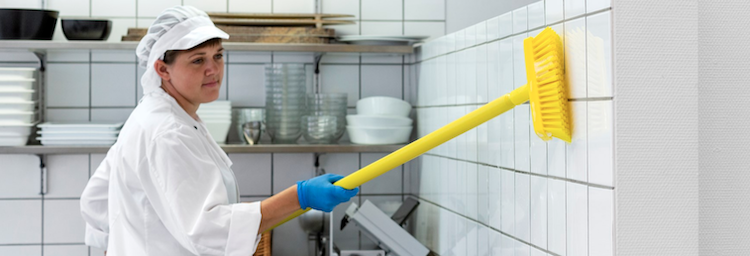Manual cleaning has never been more important.
Advice to hotels, restaurants and catering (HoReCa) establishments on hygiene measures prior to re-opening.
Hotels, restaurants and catering (HoReCa) businesses have been some of the hardest hit during the Covid-19 global pandemic. Many have been forced to close and now await further advice on when and how they should re-open. When they eventually do so there will be many things to consider, including how to ensure that their ‘mothballed’ facilities are safe and hygienic to operate prior to re-opening.
Why decontaminate before re-opening?
However diligent you were before closing a HoReCa facility, i.e., cleaning and disinfection of equipment and surfaces; establishment of appropriate pest management programmes; removal of perishable foods, ingredients, and waste; etc…, maintaining good hygiene during a period of shut down will still be a challenge.
Legally you have a responsibility to ensure that the hygiene of your building, products and services does not present a risk to safety. Equally, with regard to the provision of food and drink, you have a responsibility to ensure food safety and hygiene. European Regulation (EC) No’s 178/2002 and 852/2004 relate to food safety and hygiene, and No. 1169/2011 relates to allergen control. All state that it is an offence to sell food that is unfit/unsafe for human consumption. Food may be unfit for consumption if it is contaminated with pathogens, undeclared allergens and foreign bodies (including pests). Minimising the food safety risks from these hazards should already form part of your Food Safety Management System (FSMS). Additionally, UK Government advice in response to the Covid-19 pandemic, states that ‘You should carry out a thorough clean of your food premises and equipment before re-starting operations.’
Prepare for decontamination
- Make sure you have the right cleaning tools, chemicals and personal protective equipment (PPE) to undertake a through decontamination.
- Clean and disinfect all existing and new cleaning tools and PPE prior to use.
- Make sure that the PPE, cleaning tools, tool storage, chemicals, and chemical dosing systems are fit for purpose, i.e., not damaged, worn, or out of date.
- Review your Food Safety Management System, your colour-coding requirements, and your cleaning and disinfection operating procedures.
- Ensure that the staff involved are trained and competent.
Areas to consider for targeted decontamination prior to re-opening (not exhaustive):
- All food and drink storage facilities and production equipment, from raw materials to service/packing/delivery.
- All food contact surfaces – open and closed, and in nooks and crannies.
- All sanitary fittings - sinks, showers, baths, bidet, toilets, drains and gullies.
- All textiles – napkins, tablecloth, bed linen; and soft furnishing - sofas, mattresses, carpets, curtains.
- All hard surfaces – tables, chairs, floors, walls, ceilings, light fittings, pipework, ledges, cable trunking.
- All tableware - cutlery, plates, glasses, cups, condiment/serviette containers.
- All leisure facilities – bars, gyms, swimming pools (ensure that concentrations of disinfectant in water are maintained at an effective level), saunas, spas.
- All protective clothing – re-useable overalls, aprons, gloves, captive footwear.
- All service vehicles.
Prior to re-opening facilities should also ensure the hygiene and correct functioning of air conditioning systems, sanitary systems, water systems, laundry and dishwashing systems, hand washing and drying facilities.
Open surface decontamination
Dust and debris will accumulate on any exposed surface. Contamination may include dead insects and pest waste, both of which present a microbial and foreign body hazard. This contamination is easily removed by brushing; dry dusting or damp wiping using cloths, including microfibre; and vacuuming. Stubborn debris can be removed by scraping and brushing (dry cleaning); or scrubbing and rinsing (wet cleaning). Surfaces should be disinfected, as appropriate, after cleaning.

Deep cleaning and disinfection
Contamination doesn’t just sit on open surfaces. Debris can accumulate deep within equipment, fixtures and fittings and, if left untouched for long periods of time, these areas may become a breeding ground for microbes and pests, and a significant source of contamination when the equipment is used again. To minimise this risk Vikan recommends that all food contact equipment and sanitary fittings, where possible, should be disassembled, deep cleaned, and thoroughly disinfected, prior to re-use. Equipment parts can be cleaned by brushing; dry dusting or damp wiping using cloths, including microfibre; and vacuuming. Stubborn debris can be removed by scraping and brushing (dry cleaning); or soaking, scrubbing and rinsing (wet cleaning). All components should be disinfected, as appropriate, after cleaning.

After decontamination
- Clean and disinfect re-useable cleaning tools and PPE.
- Store equipment appropriately, e.g. on shadow boards or racks.
- On re-opening reinstate usual cleaning and disinfection practices, with consideration to some additional actions related to the on-going control of Covid-19 transmission.
Source :
https://www.vikan.com/int/services/vikan-blog/manual-cleaning-has-never-been-more-important/

